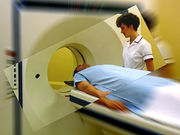Findings for computed tomography scanning followed by adrenal venous sampling
MONDAY, Nov. 16, 2015 (HealthDay News) — For patients with resistant hypertension (RH), computed tomography (CT) scanning followed by adrenal venous sampling (AVS) is a cost-effective screen for primary aldosteronism (PA), according to a study published online Nov. 10 in Circulation: Cardiovascular Quality and Outcomes.
Carrie C. Lubitz, M.D., M.P.H., from Massachusetts General Hospital in Boston, and colleagues examined whether the long-term cardiovascular benefit of identifying and treating surgically correctable PA outweighs the increased upfront costs. A decision-analytic model was used to compare aggregate costs and systolic blood pressure changes for six diagnostic strategies for PA in a simulated population of at-risk RH patients. A seventh strategy whereby all patients were treated with a mineralocorticoid-receptor antagonist without further testing was also evaluated. Changes in systolic blood pressure were converted into gains in quality-adjusted life-years (QALYs); incremental cost-effectiveness ratios were calculated using QALYs and lifetime costs.
The researchers found that, compared with treating all, the incremental cost-effectiveness ratio for CT followed by AVS was $82,000/QALY. For CT alone and AVS alone, the incremental cost-effectiveness ratios were $200,000/QALY and $492,000/QALY, respectively; other strategies were less effective and more costly.
“Primary hyperaldosteronism is a common disease that is currently, grossly underdiagnosed and treated,” the authors write. “Our results suggest that CT followed by AVS is a cost-effective strategy to screen for PA among patients with RH.”
Copyright © 2015 HealthDay. All rights reserved.








